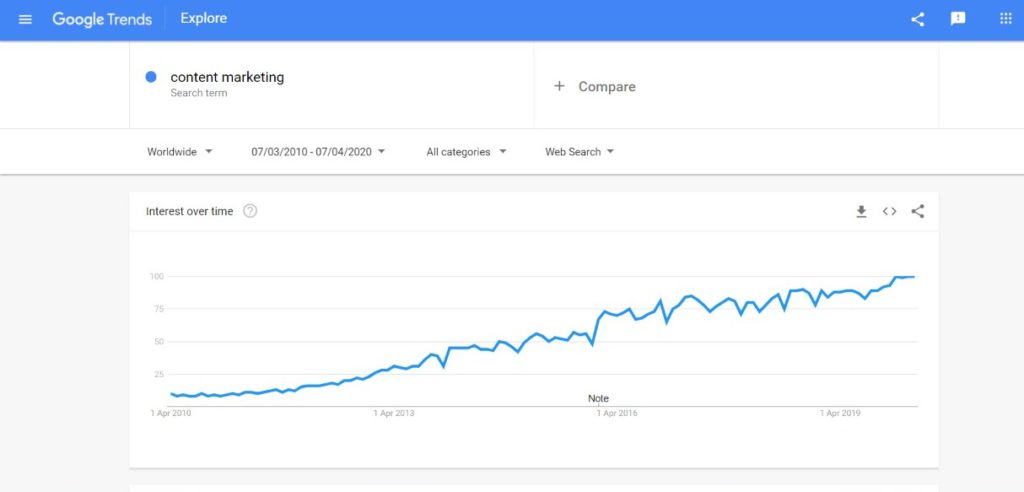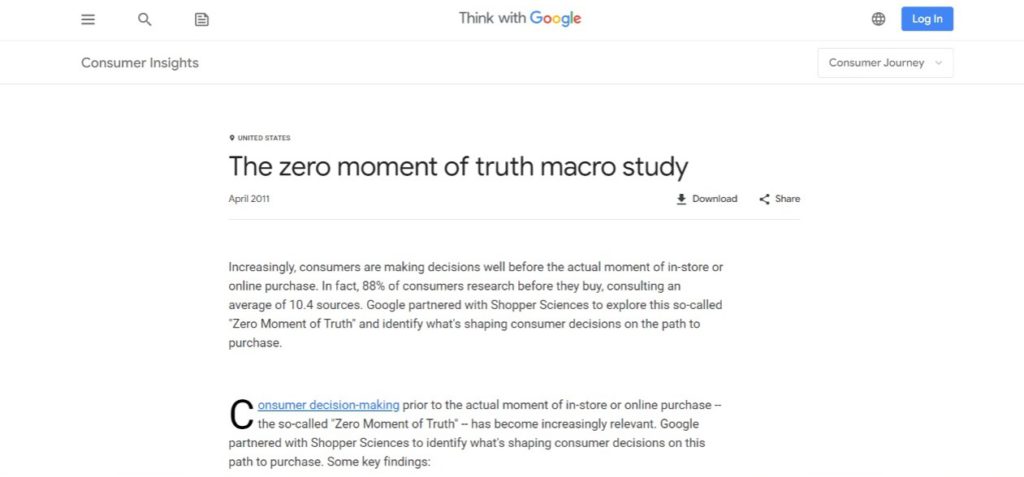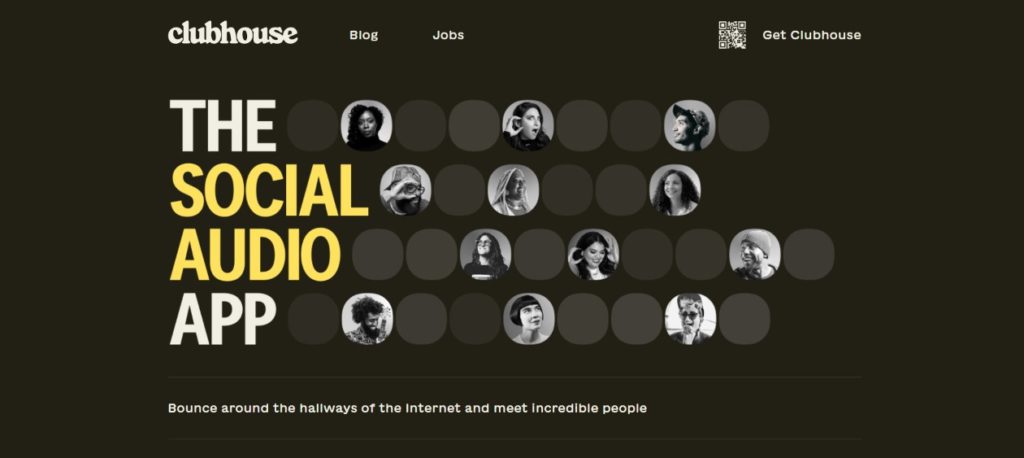The Evolution of Content Marketing as We Know it Today

‘Content is king’ — the great visionary, Bill Gates, said in 1996. Now, 25 years later, his words ring truer than ever.
If content marketing was a mere buzzword in the early 2000s, it is the norm today. A solid content marketing strategy is a prerequisite for any kind of business now. Content marketing trends show that 60% of marketers create at least one piece of content each day (Emarketer). It has taken off in the B2B space, with 42% of marketers considering themselves masters of effective content. Perhaps its widespread usage has been evident from the start as most organizations are leveraging content marketing to establish brand identity, generate leads, convert prospects into customers and retain a loyal, paying fanbase.
Content marketing’s rise in popularity can be seen from the following chart on content marketing trends:

So you might be tempted to hop on to the content marketing bandwagon, but that is easier said than done. Content marketing is not static; it’s highly dynamic with a continuously evolving landscape. What was THE fad merely five years ago has drifted into obscurity and has become obsolete today (we’re looking at you, Facebook status updates). In such a fluctuating scenario, we must look at the evolution of content marketing over the years. Let us delve into the story of its origin and try to forecast its future.
But first, let us look at the current definition.
The definition of content marketing in 2021

As we can see, content marketing comprises the creation and distribution of helpful content like blogs, images, videos, and ebooks to solve a user’s pain point. The key difference between this and traditional marketing is that content marketing is non-branded. It is not crafted with the intention of advertising one’s product or services; it serves to offer high-value information to anyone who seeks it.
It’s a method to pull people in rather than shoving content (pushy ads) down the throat. What used to be an afterthought ten years ago is now becoming a centerpiece of marketing discussions today.
Content marketing has really evolved through the years. Broadly, there were two major phases, the pre-internet, and the post-internet phases. We can divide the post-internet phase further into three stages decade-wise to understand the evolution of content marketing in detail.

Growth of content marketing
Stage 1: Pre-internet
If you thought content marketing didn’t exist before the internet, you couldn’t be more wrong. It did, albeit in a vastly different form. The origin of content marketing can be traced back to John Deere’s eponymous lifestyle magazine for farmers, The Furrow, back in 1895. This magazine was not a shameless catalog of its own products. Instead, it contained information about the latest farming technologies and trends, stuff that can make a farmer more wealthy. Deere hoped that farmers would remember the name and come back to purchase his equipment. And they did come back, which is supported by the fact that the magazine is still in circulation!

Another content marketing pioneer is Jell-O, which launched a cookbook with recipes containing their sweet, gelatinous products. Again, it wasn’t a blatant advertisement but more like an inconspicuous product placement. The cookbook went viral, helping Jell-O amass $1 million in sales in just two years!
These are just two examples of erstwhile content marketing, which was mostly done door-to-door and deployed physical material like brochures, books, magazines, and catalogs.
Stage 2: The post-internet
The 1990s
If the pre-internet era was the wild west for content marketing, this period was rock-and-roll. The internet heralded a tectonic shift in the way brands reached people. Distribution costs became zero, and the reach became unlimited.
This was the decade when websites became cool, with every brand wanting to create a webpage to keep pace with the changes.
1994 witnessed the creation of the first online blog, according to the New Yorker. Microsoft launched its first corporate blog in 1998 and never looked back, spending $20 billion on content in the next three years. All this set the stage for the grand entrance of sponsored content, with Artisan Entertainment’s indie film ‘The Blair Witch Project’ leading the way.
According to The Drum, the movie was a huge hit at the box office, thanks to its trendsetting digital promotions, which involved the creation of multiple ‘conspiracy theory websites’ to create a buzz about its plot points. The first documented example of viral content, if you will.
The 2000s
This decade can be seen as the inflection point for content marketing growth as Google came and changed the game. Because till this point, consumers were still accustomed to brands reaching out to them, and not vice versa.
With the rise of Google, search became the dominant online behavior and primary buying action, spawning an entirely new industry (SEO). This was proved by Google’s seminal Zero Moment Of Truth study, which found that 88% of consumers like to research a product online before deciding to buy it—this came to be known as the ‘discovery and awareness’ stage of the sales funnel. This study gave a huge boost to the SEO industry, and content marketing became geared more and more towards mastering Google’s Page Rank algorithm and coming on top of the SERPs (and staying there).

The 2010s
If ‘Search’ dominated the first decade of the millennium, the second was characterized by ‘Social’. The Search was all about intent, where users proactively wanted to look something up to have their questions answered. But social media changed the way people consumed content.
People preferred browsing content mindlessly on Facebook and Twitter feeds, Instagram Stories, and YouTube videos. No longer did people go looking for content; content found its way to them. Content consumption became more passive, and this led to a flurry of catchy, shareable content. Social media feeds became inundated with branded content, and people became habituated to discovering new products on social media platforms. Content marketing trends show a spike in social media usage in the last five years, according to Statista.
2021 & beyond
This brings us to the billion-dollar question — what does the future hold in store for the content marketing industry? A few recurring themes emerge:
- Content has to be geared towards mobile. About 61% of Google searches were carried out on mobile devices in 2019, says Statista, meaning content has to be tailored to look good on small screens.
- Videos have to figure prominently in your content strategy as content marketing trends indicate that 82% of businesses had video as the cornerstone of their marketing arsenal in 2020.
- Newer content formats will continue to pop up. Feed > Stories > Reels > Branded live streams?
- It seems audio could be the breakout medium. The surge in popularity of podcasts and audio-first social networks like Clubhouse (10 million weekly active users and growing) lend credence to this hypothesis. This has been further accelerated by the pandemic and people wanting to reduce their screen time.

Change is the only constant in life, and this adage applies perfectly to content marketing.
Consumer habits will keep evolving, and the content will have to keep up. Content marketers will have to constantly reinvent themselves by keeping themselves abreast of the latest developments and producing content that’s on-trend. Otherwise, they run the risk of being rendered irrelevant.
Problems and challenges in content marketing strategies
Like any other business venture, everyone faces problems in their digital content marketing journey. Old trends are transforming into newer ones. Let’s examine what challenges you are likely to face in your digital content marketing strategies and how you can overcome them.
Lack of time
There is never enough time. Managing time is sometimes beyond your control. Content jobs are divided into who will write content, who will edit, who will approve, and who will post it. Effective content governance is the only way out. There needs to be ownership of the job at every step of the process. This way, the entire process can be handled in a more organized manner.
Quality of content and consistency in online content marketing
Consistency is key. Failing to publish content consistently is a recipe for disaster. When you do not post content regularly, you tend to lose your viewers and prospective customers gradually. Schedule your content in an organized manner.
Quality content is free of fluff that can tire a reader out. Always present fresh content that is better than that of your competitor. Optimize your page for SERPs so that it gets the maximum number of views. And for all this to fall in place, it is important that you know your readers’ interests.
Paying for digital content marketing strategies
Paid content is always a winner against organic ones. Paid posts have a better reach. There are times when organic content does play a crucial role in building an audience and keeping them engaged, but you must also publish paid content that targets the right consumers. It helps when you have to reach the highest number of people in a short period of time, as the social channels do not allow it unless you have paid for promotion.
Creating engaging content
Engaging content creation is easier said than done. To enhance the success of content marketing, it has to be effective and must stay relevant for a longer period. It is a continuous effort that asks for rigorous research and study of users.
Generating leads
It is the most challenging task for every content marketer globally. When creating engaging content, there are two main questions that any marketer must ask themselves. Is the content of the kind people would pay for? And, do you actually know the type of content your readers are looking for?
At times users are looking for videos to educate them about products, while at other times, they would prefer to read engaging posts. While producing videos, consider their length. Short videos still rule the roost, but long, interesting videos do catch viewers’ attention. Refer to analytics and use efficient tools to understand the type of content that will resonate with your audience. Generate your leads and find your target audience.

FAQs
Content marketing involves creating and distributing helpful and meaningful content like blogs, images, videos, and ebooks to solve a user’s pain point.
Pre-internet content marketing was mostly done door-to-door and deployed physical materials like brochures, books, magazines, and catalogs.
According to the New Yorker, the first online blog was launched in 1994. Microsoft launched its first corporate blog in 1998 and never looked back, spending $20 billion on content in the next three years.
Yes, paid content has been proven to have more reach and effectiveness as such content not only shows up in your reader’s feed but is also pushed to new users.
Get a firm grasp on the sales funnel. As a content strategist, one must know the critical stages of the content journey.
Analyze the data. Every piece of content generates an impact. Try to evaluate the data and detect any trends.
Strategize your moves. Always stay aligned with your team or with yourself by making a comprehensive action plan.
Repurpose your content. Don’t hesitate to alter your content according to a particular platform. Whatever suits your fit, just do it.
Personalize your content. Remember that people want to follow other people and not brands. Bring them home with effective storytelling!
Build communities. Be inclusive of your audience. Offer them a periodic incentive to stay engaged. Some examples include ebooks, newsletters, webinars, giveaways.
Post long-form content. Optimize your content according to your niche with long-tail keywords. This trend is becoming more relevant due to low competition.
Produce video content. YouTube is a great way to start building your virtual presence. You can start interesting series, meet-ups, or informational videos, whatever you deem fit.
Loop-in experts. Keep inviting expert personnel regularly to engage with your audience. This also gives them a chance to network.
Latest Blogs
Explore how Google’s 2025 AI search updates triggered ranking chaos. Learn actionable strategies to adapt your SEO for AI Overviews, zero-click searches, and SERP volatility. Stay ahead now.
Learn how to rank on AI search engines like ChatGPT, Perplexity, and Gemini by optimizing your content for authority, structure, and relevance. Stay ahead in AI-driven search with this strategic guide.
Explore the best healthcare SEO services for your medical practice. Improve online visibility and effectively reach more patients in need of your services.
Get your hands on the latest news!
Similar Posts

Content Marketing
4 mins read
11 Best B2B Content Marketing Agencies for B2B Companies in 2024

Content Marketing
5 mins read
Top ecommerce Marketing Agencies with Proven Strategies for 2024

Content Marketing
5 mins read